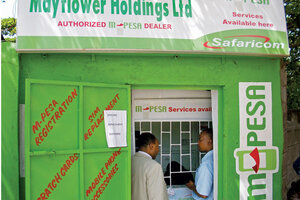Kenya: Taking money out of banks' hands – with cellphones
Since cellphones became widely used in Kenya five years ago, they've become the bank card du jour.

Customers at an M-PESA kiosk.
Kipchumba Some
Nairobi, Kenya
• A local, slice-of-life story from a Monitor correspondent.
For a people that embraced the commercial use of mobile telephones just five years ago, Kenyans have become quite innovative in making the gadgets work for them.
With a mobile phone, one can pay electricity and water bills, pay for goods at the supermarket, buy airline or bus tickets, withdraw money from an ATM, monitor stocks, and even check bank account balances.
All these possibilities stem from an invention called M-PESA (“mobile phone money,” in Kiswahili) by Kenya’s largest service provider, Safaricom.
Originally, M-PESA was designed to let customers send and receive modest sums of money (up to $500) using their mobile phones. But since its introduction three years ago, it has spawned new uses by the day.
The Kenya Police are considering a tool created by a teenage college student that allows traffic officers to book and issue court summonses to traffic offenders via phone.
The same student designed a mobile phone program that can track and disable your car in case it is stolen or broken into. Security companies are said to be very interested.
While ordinary Kenyans are quite happy about the hassles the service has spared them, such as long lines, local banks are not amused.
The service has significantly decreased the daily volume of transactions going through banks. Some 8 million customers move nearly half a billion dollars via the M-PESA system every month.
Safaricom recently extended M-PESA services to Britain, allowing Kenyans there to send money to relatives back home. Plans are said to be under way to take it to the United States, too.
